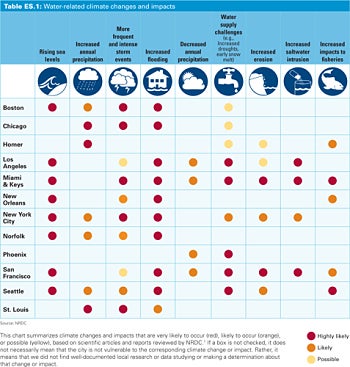
La página que intenta visitar sólo está disponible en inglés. ¡Disculpa!
The page you are about to visit is currently only available in English. Sorry!


What problems do your city face? Credit: NRDC
Do you dwell in a city? If so, do the words ‘rising sea levels,’ ‘storm surges,’ ‘drought,’ and ‘erosion,’ make you nervous? Well apparently they concern the Natural Resources Defense Council (NRDC). In a report released earlier today, researchers from the NRDC identified the water-related issues that twelve cities around the U.S. face, including New York, Chicago, and Los Angeles. Did yours make the cut?
Climate change will be to blame in the potential aqua-havoc that cities could experience, the researchers explained. Increased temperatures caused by global warming lead to an intensification of the water cycle, where air is continually being evaporated and precipitated. More intense evaporations lead to more intense droughts, and more intense precipitations lead to more intense downpours, which could result in flooding, as seen in the Mississippi River earlier this year.
Threats that cities could face include more severe storms and droughts, flooding, and rising sea levels, which the researchers likened to a slow moving tsunami during a media conference earlier today. For example, one challenge metropolitan areas in the western U.S. face is water management. Cities such as Seattle rely on snowmelt from the mountains during the spring for the summer water supply. However, higher winter temperatures can lead to less snow fall, and spring meltwater could disappear altogether, creating troubling problems for water guzzling cities such as
Although these problems are disconcerting, the report also goes over the various steps that cities have taken to tackle these challenges. For example,
But what if your city isn’t on this list? Or you don’t live in one? Fear not! The NRDC plans on releasing a state-by-state report later this year so stay tuned. And remember, whether you live in close-knit quarters or in the countryside, climate change is a global problem.